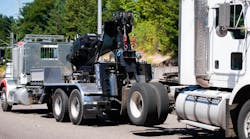Operating under the current federal Hours of Service (HOS) regs for nearly four-and-half months now has been plenty long enough for many motor carriers, logistics providers and truck drivers to be reporting that they are being hit hard by operational impacts that are both causing financial pain and reducing highway safely.
Given that court challenges to the Federal Motor Carrier Safety Admin.’s (FMCSA) promulgation of the HOS rules over the year have changed little, it’s little wonder that trucking stakeholders are lobbying Congress to deploy its oversight function to get FMCSA to rewrite these regs to better reflect the realities of transporting freight—both productively and safely.
For example, this Thursday the Subcommittee on Contracting and Workforce of the House Small Business Committee, chaired by Rep. Sam Graves (R-MO), will conduct a hearing on the impact of HOS on small businesses.
According to the subcommittee’s chairman, Rep. Richard Hanna (R-NY), the hearing will “examine the economic and operational impact of the Federal Motor Carrier Safety Administration’s new Hours of Service regulation on small businesses, particularly those in the commercial freight and transportation logistics industries.
Rep. Hanna pointed out in a statement that “even though highway accidents involving commercial motor vehicles declined by more than 29% under the agency’s previous Hours of Service regulations, FMCSA went ahead with new regulations that are causing negative economic and operational impacts on the trucking industry and which may also be undermining highway safety by encouraging more driving during peak hours.
“I look forward to learning from the witnesses how they are operating under this rule and examining how we can better balance the needs of our economy and the important goal of highway safety,” he added.
Witnesses scheduled for the hearing include Anne Ferro, Administrator of the FMCSA as well as carrier, logistics and broker executives representing the American Trucking Assns. (ATA), the Owner-Operator Independent Drivers Assn. (OOIDA) and the Transportation Intermediaries Assn.
Certainly, the highly detailed, nearly 60-pg long analysis contained in the “Operational and Economics Impacts of the New Hours-of-Service” research report just released by the American Transportation Research Institute (ATRI) will provide plenty of ammo in the battle to see the HOS regs revised to address trucking’s urgent concerns.
Noting how thorough this research is, ATRI said the analysis, prepared by senior research associate Jeffrey Short, is based on i survey data of over 2,300 commercial drivers and 400 motor carriers as well as a detailed analysis of logbook data for over 40,000 commercial drivers.
Key operational and economic impacts ATRI identified include:
- More than 80% of the motor carriers surveyed have experienced a productivity loss since the new rules went into effect-- with nearly half stating that they require more drivers to haul the same amount of freight
- Among commercial drivers surveyed, 82.5% indicated that the new HOS rules have had a “negative” impact on their quality of life-- with more than 66% indicating increased levels of fatigue.
- Drivers are [being] forced to drive in more congested time periods, although the FMCSA Regulatory Impact Analysis did not address increased safety risks with truck-traffic diversion to peak hour traffic
- Majority of drivers (67%) report decreases in pay since the rules took effect
- Impacts on driver wages for all over-the-road drivers total $1.6 billion to $3.9 billion in annualized loss
ATRI said its findings apply to three key areas: driver pay impacts, carrier productivity impacts and safety impacts.
As to the majority of drivers reporting a drop in pay since July 1st, ATRI pointed out that those losses “could be attributed to myriad factors” related to the HOS rule changes including:
- Schedule changes to meet requirements of the restart provisions
- Increased restart times
- Reverting back to use of a “rolling schedule”
- Lost loads due to decreased flexibility
- Rest-break requirement increasing unproductive on-duty time (e.g. finding truck parking)
AATRI said “key carrier outcomes that result from the HOS changes, including those related to productivity loss,” are:
- More drivers now required to move same amount of freight: To comply with the HOS rules, carriers have shifted driver schedules. Many of these new schedules have resulted in a decrease in the number of weekly miles a driver can log. Due to the decrease in miles, carriers have a choice of turning down freight or making up the miles by incorporating additional drivers and/or equipment into their operations. These options are less efficient than operations prior to the new HOS rules, and are a central component of the productivity loss
- Driver shortage/turnover: Prior to the July 1st HOS rules, qualified drivers were scarce with an estimated shortage of 20,000 to 25,000 for-hire truckload drivers.7As a result of the changes more drivers are required and the level of scarcity has increased. To attract drivers after the HOS change, some carriers have opted to increase pay and some may increase rates for shippers. Rate hikes are challenging, however, due to strong competition among industry participants. If rate increases do not fully compensate for driver pay increases then carriers raising pay will assume an additional financial burden
- Decreased flexibility to meet customer requirements: In particular, drivers are limited to one restart per week and must take those restarts across two nighttime periods. Shippers, however, may require delivery at any point on a given day, and with little notice. The data show, particularly those data describing the variability in driver weekly work time, that flexibility has decreased. As a result, drivers are less able to accumulate hours for unanticipated shipper requests via the 34-hour restart. In many instances, carriers must either turn down business or increase driver capacity
As to the safety impact, ATRI stated that while the “goals of the July 1st HOS changes were to make the existing rules even safer, what has instead happened is that “drivers have indicated increases in fatigue since the rules were implemented.”
In addition, ATRI shared these other safety-rlated findings:
- Drivers and carriers remain uncertain about the enforceability of the new rules
- Evidence points to the rules having increased time working and time away from home for many drivers. Some drivers have indicated that due to the rest break requirement, for instance, typical work day lengths have actually increased. Nearly 20 percent indicated an increase in on-duty time, though miles and pay have decreased or remained constant.
- Still others have indicated that due to the changes, off-duty time has been required away from home more often-- thus decreasing the restorative benefits of the rest period
“Trucking is not a ‘one-size-fits-all’ industry,” ATRI said in its conclusion. “Even so, there has been a clear, measurable and generally negative impact to a significant portion of the industry resulting from the July 1st HOS rules implementation.”
ATRI stated plainly that its report “demonstrates clear evidence that the rules have generated a financial consequence on individual drivers as well as motor carriers, the majority of whom are small businesses.
“The financial impacts are realized through decreased earnings for drivers, decreased efficiency and productivity for carriers and, as trucking capacity tightens due to an increasing driver shortage, increased rates for businesses that ship goods,” the report advised.
“Finally, the commercial vehicle shift, described herein, to congested time periods creates new crash risks and costs that have not yet been quantified by FMCSA,” ATRI summed up.
Click here to submit a form to receive the full report from ATRI.
ATRI, which is part of the American Trucking Assns. Federation, noted that due to its “prominence within the trucking industry, state and federal agencies [also] turn to ATRI for trucking-related research.”



